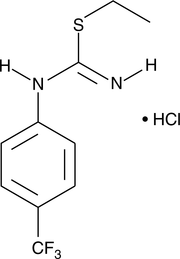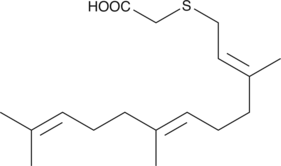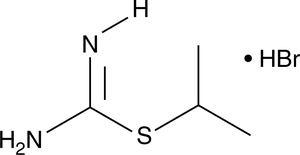Chemicals
Showing 34801–34950 of 41137 results
-
Rutin is a flavonoid glycoside that has been found in buckwheat and has diverse biological activities.{30137,31793,16519,31794,31795} It scavenges 2,2-diphenyl-1-picrylhydrazyl (DPPH; Item No. 14805) and ABTS (Item No. 27317) radicals when used at a concentration of 163.79 µM, as well as inhibits iron autoxidation, in cell-free assays.{30137,31793} Dietary administration of rutin (0.2% w/v) reduces tumor growth and the number of lung metastases in a B16/F10 murine melanoma model.{16519} Rutin (50 and 100 mg/kg) decreases intestinal acidity, increases intestinal activity of superoxide dismutase (SOD) and catalase, and reduces intestinal levels of protein carbonyls and thiobarbituric acid reactive substances (TBARS) formation in a rat model of intestinal toxicity induced by methotrexate (Item No. 13960).{31794} It also increases the time spent exploring the novel object in the novel object recognition (NOR) test and increases recognition and discriminative indices in a rat model of short-term episodic memory deficits induced by scopolamine (Item No. 14108).{31795}
Brand:CaymanSKU:19868 -Available on backorder
Rutin is a flavonoid glycoside that has been found in buckwheat and has diverse biological activities.{30137,31793,16519,31794,31795} It scavenges 2,2-diphenyl-1-picrylhydrazyl (DPPH; Item No. 14805) and ABTS (Item No. 27317) radicals when used at a concentration of 163.79 µM, as well as inhibits iron autoxidation, in cell-free assays.{30137,31793} Dietary administration of rutin (0.2% w/v) reduces tumor growth and the number of lung metastases in a B16/F10 murine melanoma model.{16519} Rutin (50 and 100 mg/kg) decreases intestinal acidity, increases intestinal activity of superoxide dismutase (SOD) and catalase, and reduces intestinal levels of protein carbonyls and thiobarbituric acid reactive substances (TBARS) formation in a rat model of intestinal toxicity induced by methotrexate (Item No. 13960).{31794} It also increases the time spent exploring the novel object in the novel object recognition (NOR) test and increases recognition and discriminative indices in a rat model of short-term episodic memory deficits induced by scopolamine (Item No. 14108).{31795}
Brand:CaymanSKU:19868 -Available on backorder
Janus-associated kinases (JAKs) are cytoplasmic tyrosine kinases that are required for activating the signaling of certain cytokines and growth factor receptors.{19346,20362} A JAK2 gene fusion mutation, JAK2V617F, that causes unchecked activation of various growth factors and cytokines, has been linked to myeloproliferative neoplasms (MPNs), including polycythemia vera, essential thrombocythemia, and primary myelofibrosis.{21781} Ruxolitinib is a potent ATP mimetic that inhibits both JAK1 and JAK2 with IC50 values of 2.7 and 4.5 nM, respectively and is relatively less selective for JAK3 (IC50 = 322 nM).{21781} It can block interleukin-6 (IL-6) signaling (IC50 = 281 nM) and proliferation of JAK2V617F+ Ba/F3 cells (IC50 = 127 nM).{21782} In primary cultures, ruxolitinib preferentially suppresses erythroid progenitor colony formation from JAK2V617F+ polycythemia vera patients (IC50 = 67 nM) versus healthy donors (IC50 > 400 nM).{21782} In a mouse model of JAK2V617F+ MPN, 90 mg/kg ruxolitinib reduced splenomegaly, decreased circulating levels of IL-6 and TNF-α, eliminated neoplastic cells, and prolonged survival of the treated animals.{21782}
Brand:CaymanSKU:11609 - 1 mgAvailable on backorder
Janus-associated kinases (JAKs) are cytoplasmic tyrosine kinases that are required for activating the signaling of certain cytokines and growth factor receptors.{19346,20362} A JAK2 gene fusion mutation, JAK2V617F, that causes unchecked activation of various growth factors and cytokines, has been linked to myeloproliferative neoplasms (MPNs), including polycythemia vera, essential thrombocythemia, and primary myelofibrosis.{21781} Ruxolitinib is a potent ATP mimetic that inhibits both JAK1 and JAK2 with IC50 values of 2.7 and 4.5 nM, respectively and is relatively less selective for JAK3 (IC50 = 322 nM).{21781} It can block interleukin-6 (IL-6) signaling (IC50 = 281 nM) and proliferation of JAK2V617F+ Ba/F3 cells (IC50 = 127 nM).{21782} In primary cultures, ruxolitinib preferentially suppresses erythroid progenitor colony formation from JAK2V617F+ polycythemia vera patients (IC50 = 67 nM) versus healthy donors (IC50 > 400 nM).{21782} In a mouse model of JAK2V617F+ MPN, 90 mg/kg ruxolitinib reduced splenomegaly, decreased circulating levels of IL-6 and TNF-α, eliminated neoplastic cells, and prolonged survival of the treated animals.{21782}
Brand:CaymanSKU:11609 - 10 mgAvailable on backorder
Janus-associated kinases (JAKs) are cytoplasmic tyrosine kinases that are required for activating the signaling of certain cytokines and growth factor receptors.{19346,20362} A JAK2 gene fusion mutation, JAK2V617F, that causes unchecked activation of various growth factors and cytokines, has been linked to myeloproliferative neoplasms (MPNs), including polycythemia vera, essential thrombocythemia, and primary myelofibrosis.{21781} Ruxolitinib is a potent ATP mimetic that inhibits both JAK1 and JAK2 with IC50 values of 2.7 and 4.5 nM, respectively and is relatively less selective for JAK3 (IC50 = 322 nM).{21781} It can block interleukin-6 (IL-6) signaling (IC50 = 281 nM) and proliferation of JAK2V617F+ Ba/F3 cells (IC50 = 127 nM).{21782} In primary cultures, ruxolitinib preferentially suppresses erythroid progenitor colony formation from JAK2V617F+ polycythemia vera patients (IC50 = 67 nM) versus healthy donors (IC50 > 400 nM).{21782} In a mouse model of JAK2V617F+ MPN, 90 mg/kg ruxolitinib reduced splenomegaly, decreased circulating levels of IL-6 and TNF-α, eliminated neoplastic cells, and prolonged survival of the treated animals.{21782}
Brand:CaymanSKU:11609 - 25 mgAvailable on backorder
Janus-associated kinases (JAKs) are cytoplasmic tyrosine kinases that are required for activating the signaling of certain cytokines and growth factor receptors.{19346,20362} A JAK2 gene fusion mutation, JAK2V617F, that causes unchecked activation of various growth factors and cytokines, has been linked to myeloproliferative neoplasms (MPNs), including polycythemia vera, essential thrombocythemia, and primary myelofibrosis.{21781} Ruxolitinib is a potent ATP mimetic that inhibits both JAK1 and JAK2 with IC50 values of 2.7 and 4.5 nM, respectively and is relatively less selective for JAK3 (IC50 = 322 nM).{21781} It can block interleukin-6 (IL-6) signaling (IC50 = 281 nM) and proliferation of JAK2V617F+ Ba/F3 cells (IC50 = 127 nM).{21782} In primary cultures, ruxolitinib preferentially suppresses erythroid progenitor colony formation from JAK2V617F+ polycythemia vera patients (IC50 = 67 nM) versus healthy donors (IC50 > 400 nM).{21782} In a mouse model of JAK2V617F+ MPN, 90 mg/kg ruxolitinib reduced splenomegaly, decreased circulating levels of IL-6 and TNF-α, eliminated neoplastic cells, and prolonged survival of the treated animals.{21782}
Brand:CaymanSKU:11609 - 5 mgAvailable on backorder
Ruxolitinib is a potent ATP mimetic that inhibits both JAK1 and JAK2 with IC50 values of 2.7 and 4.5 nM, respectively, and is relatively less selective for JAK3 (IC50 = 322 nM).{21781} It blocks interleukin-6 (IL-6) signaling (IC50 = 281 nM) and proliferation of JAK2V617F+ Ba/F3 cells (IC50 = 127 nM).{21782} In primary cultures, ruxolitinib preferentially suppresses erythroid progenitor colony formation from JAK2V617F+ polycythemia vera patients (IC50 = 67 nM) versus healthy donors (IC50 > 400 nM). In a mouse model of JAK2V617F+ myeloproliferative neoplasms (MPN), 90 mg/kg ruxolitinib reduces splenomegaly, decreases circulating levels of IL-6 and TNF-α, eliminates neoplastic cells, and prolongs survival.
Brand:CaymanSKU:23215 - 1 mgAvailable on backorder
Ruxolitinib is a potent ATP mimetic that inhibits both JAK1 and JAK2 with IC50 values of 2.7 and 4.5 nM, respectively, and is relatively less selective for JAK3 (IC50 = 322 nM).{21781} It blocks interleukin-6 (IL-6) signaling (IC50 = 281 nM) and proliferation of JAK2V617F+ Ba/F3 cells (IC50 = 127 nM).{21782} In primary cultures, ruxolitinib preferentially suppresses erythroid progenitor colony formation from JAK2V617F+ polycythemia vera patients (IC50 = 67 nM) versus healthy donors (IC50 > 400 nM). In a mouse model of JAK2V617F+ myeloproliferative neoplasms (MPN), 90 mg/kg ruxolitinib reduces splenomegaly, decreases circulating levels of IL-6 and TNF-α, eliminates neoplastic cells, and prolongs survival.
Brand:CaymanSKU:23215 - 10 mgAvailable on backorder
Ruxolitinib is a potent ATP mimetic that inhibits both JAK1 and JAK2 with IC50 values of 2.7 and 4.5 nM, respectively, and is relatively less selective for JAK3 (IC50 = 322 nM).{21781} It blocks interleukin-6 (IL-6) signaling (IC50 = 281 nM) and proliferation of JAK2V617F+ Ba/F3 cells (IC50 = 127 nM).{21782} In primary cultures, ruxolitinib preferentially suppresses erythroid progenitor colony formation from JAK2V617F+ polycythemia vera patients (IC50 = 67 nM) versus healthy donors (IC50 > 400 nM). In a mouse model of JAK2V617F+ myeloproliferative neoplasms (MPN), 90 mg/kg ruxolitinib reduces splenomegaly, decreases circulating levels of IL-6 and TNF-α, eliminates neoplastic cells, and prolongs survival.
Brand:CaymanSKU:23215 - 25 mgAvailable on backorder
Ruxolitinib is a potent ATP mimetic that inhibits both JAK1 and JAK2 with IC50 values of 2.7 and 4.5 nM, respectively, and is relatively less selective for JAK3 (IC50 = 322 nM).{21781} It blocks interleukin-6 (IL-6) signaling (IC50 = 281 nM) and proliferation of JAK2V617F+ Ba/F3 cells (IC50 = 127 nM).{21782} In primary cultures, ruxolitinib preferentially suppresses erythroid progenitor colony formation from JAK2V617F+ polycythemia vera patients (IC50 = 67 nM) versus healthy donors (IC50 > 400 nM). In a mouse model of JAK2V617F+ myeloproliferative neoplasms (MPN), 90 mg/kg ruxolitinib reduces splenomegaly, decreases circulating levels of IL-6 and TNF-α, eliminates neoplastic cells, and prolongs survival.
Brand:CaymanSKU:23215 - 5 mgAvailable on backorder
The bromodomain and extra terminal (BET) proteins interact with acetylated lysine-containing sequences on target proteins via their bromodomains, commonly altering gene transcription.{19044} The human BET proteins contain two bromodomains, the first (BD1) being closer to the N-terminus than the second (BD2). RVX-208 is a selective antagonist of BET bromodomains, binding with 10-100-fold higher affinity for BD2 (IC50 = 0.04-0.28 µM) over BD1 (IC50 = 1.8-3.1 µM).{26809,26810} RVX-208 causes the selective release of BET proteins from chromatin in cells.{26809,26810} It interferes with the BET protein BRD4, resulting in an increased expression of apolipoprotein (Apo) A1 in cells, mice, monkeys, and humans.{26807,26811} RVX-208 also reduces atherosclerosis in hyperlipidemic ApoE-deficient mice.{26811}
Brand:CaymanSKU:-Out of stock
The bromodomain and extra terminal (BET) proteins interact with acetylated lysine-containing sequences on target proteins via their bromodomains, commonly altering gene transcription.{19044} The human BET proteins contain two bromodomains, the first (BD1) being closer to the N-terminus than the second (BD2). RVX-208 is a selective antagonist of BET bromodomains, binding with 10-100-fold higher affinity for BD2 (IC50 = 0.04-0.28 µM) over BD1 (IC50 = 1.8-3.1 µM).{26809,26810} RVX-208 causes the selective release of BET proteins from chromatin in cells.{26809,26810} It interferes with the BET protein BRD4, resulting in an increased expression of apolipoprotein (Apo) A1 in cells, mice, monkeys, and humans.{26807,26811} RVX-208 also reduces atherosclerosis in hyperlipidemic ApoE-deficient mice.{26811}
Brand:CaymanSKU:-Out of stock
The bromodomain and extra terminal (BET) proteins interact with acetylated lysine-containing sequences on target proteins via their bromodomains, commonly altering gene transcription.{19044} The human BET proteins contain two bromodomains, the first (BD1) being closer to the N-terminus than the second (BD2). RVX-208 is a selective antagonist of BET bromodomains, binding with 10-100-fold higher affinity for BD2 (IC50 = 0.04-0.28 µM) over BD1 (IC50 = 1.8-3.1 µM).{26809,26810} RVX-208 causes the selective release of BET proteins from chromatin in cells.{26809,26810} It interferes with the BET protein BRD4, resulting in an increased expression of apolipoprotein (Apo) A1 in cells, mice, monkeys, and humans.{26807,26811} RVX-208 also reduces atherosclerosis in hyperlipidemic ApoE-deficient mice.{26811}
Brand:CaymanSKU:-Out of stock
The bromodomain and extra terminal (BET) proteins interact with acetylated lysine-containing sequences on target proteins via their bromodomains, commonly altering gene transcription.{19044} The human BET proteins contain two bromodomains, the first (BD1) being closer to the N-terminus than the second (BD2). RVX-208 is a selective antagonist of BET bromodomains, binding with 10-100-fold higher affinity for BD2 (IC50 = 0.04-0.28 µM) over BD1 (IC50 = 1.8-3.1 µM).{26809,26810} RVX-208 causes the selective release of BET proteins from chromatin in cells.{26809,26810} It interferes with the BET protein BRD4, resulting in an increased expression of apolipoprotein (Apo) A1 in cells, mice, monkeys, and humans.{26807,26811} RVX-208 also reduces atherosclerosis in hyperlipidemic ApoE-deficient mice.{26811}
Brand:CaymanSKU:-Out of stock
RWJ 52353 is an agonist of α2D-adrenergic receptors (α2D-ARs; Kis = 1.5, 254, 621, and 443 nM for α2D-, α2A-, α2B-, and α1-ARs, respectively).{51154} It has antinociceptive properties in the mouse and rat abdominal irritation tests (ED50s = 11.6 and 15.1 mg/kg, respectively).
Brand:CaymanSKU:11942 - 1 mgAvailable on backorder
RWJ 52353 is an agonist of α2D-adrenergic receptors (α2D-ARs; Kis = 1.5, 254, 621, and 443 nM for α2D-, α2A-, α2B-, and α1-ARs, respectively).{51154} It has antinociceptive properties in the mouse and rat abdominal irritation tests (ED50s = 11.6 and 15.1 mg/kg, respectively).
Brand:CaymanSKU:11942 - 10 mgAvailable on backorder
RWJ 52353 is an agonist of α2D-adrenergic receptors (α2D-ARs; Kis = 1.5, 254, 621, and 443 nM for α2D-, α2A-, α2B-, and α1-ARs, respectively).{51154} It has antinociceptive properties in the mouse and rat abdominal irritation tests (ED50s = 11.6 and 15.1 mg/kg, respectively).
Brand:CaymanSKU:11942 - 5 mgAvailable on backorder
RWJ 67657 is an orally active inhibitor of the MAP kinases p38α and p38β (IC50s = 1 and 11 µM, respectively, in vitro) that is inactive against p38γ and p38δ, as well as several other kinases.{30330} It blocks the release of TNF-α and IL-1β from peripheral blood mononuclear cells stimulated with LPS (IC50s = 3 and 11 nM, respectively) and inhibits TNF-α production in LPS-treated mice and rats.{30330} RWJ 67657 potently blocks the proliferation of CD4+ peripheral blood T cells induced by CD28 stimulation alone (IC50 = 0.5-4 nM).{30329} It is commonly used to study the roles of p38α and p38β in cellular and whole animal systems.{30328,30326,30327}
Brand:CaymanSKU:-Available on backorder
RWJ 67657 is an orally active inhibitor of the MAP kinases p38α and p38β (IC50s = 1 and 11 µM, respectively, in vitro) that is inactive against p38γ and p38δ, as well as several other kinases.{30330} It blocks the release of TNF-α and IL-1β from peripheral blood mononuclear cells stimulated with LPS (IC50s = 3 and 11 nM, respectively) and inhibits TNF-α production in LPS-treated mice and rats.{30330} RWJ 67657 potently blocks the proliferation of CD4+ peripheral blood T cells induced by CD28 stimulation alone (IC50 = 0.5-4 nM).{30329} It is commonly used to study the roles of p38α and p38β in cellular and whole animal systems.{30328,30326,30327}
Brand:CaymanSKU:-Available on backorder
RWJ 67657 is an orally active inhibitor of the MAP kinases p38α and p38β (IC50s = 1 and 11 µM, respectively, in vitro) that is inactive against p38γ and p38δ, as well as several other kinases.{30330} It blocks the release of TNF-α and IL-1β from peripheral blood mononuclear cells stimulated with LPS (IC50s = 3 and 11 nM, respectively) and inhibits TNF-α production in LPS-treated mice and rats.{30330} RWJ 67657 potently blocks the proliferation of CD4+ peripheral blood T cells induced by CD28 stimulation alone (IC50 = 0.5-4 nM).{30329} It is commonly used to study the roles of p38α and p38β in cellular and whole animal systems.{30328,30326,30327}
Brand:CaymanSKU:-Available on backorder
RWJ 67657 is an orally active inhibitor of the MAP kinases p38α and p38β (IC50s = 1 and 11 µM, respectively, in vitro) that is inactive against p38γ and p38δ, as well as several other kinases.{30330} It blocks the release of TNF-α and IL-1β from peripheral blood mononuclear cells stimulated with LPS (IC50s = 3 and 11 nM, respectively) and inhibits TNF-α production in LPS-treated mice and rats.{30330} RWJ 67657 potently blocks the proliferation of CD4+ peripheral blood T cells induced by CD28 stimulation alone (IC50 = 0.5-4 nM).{30329} It is commonly used to study the roles of p38α and p38β in cellular and whole animal systems.{30328,30326,30327}
Brand:CaymanSKU:-Available on backorder
RY785 is a selective inhibitor of Kv2.1 voltage-gated potassium channels (IC50 = 0.05 µM) that does not affect Cav2 calcium channels.{32792} It displays over 100-fold selectivity for Kv2.1 over Cav1.2 (IC50 = 17 µM).{32792}
Brand:CaymanSKU:19813 -Available on backorder
RY785 is a selective inhibitor of Kv2.1 voltage-gated potassium channels (IC50 = 0.05 µM) that does not affect Cav2 calcium channels.{32792} It displays over 100-fold selectivity for Kv2.1 over Cav1.2 (IC50 = 17 µM).{32792}
Brand:CaymanSKU:19813 -Available on backorder
RY785 is a selective inhibitor of Kv2.1 voltage-gated potassium channels (IC50 = 0.05 µM) that does not affect Cav2 calcium channels.{32792} It displays over 100-fold selectivity for Kv2.1 over Cav1.2 (IC50 = 17 µM).{32792}
Brand:CaymanSKU:19813 -Available on backorder
RY785 is a selective inhibitor of Kv2.1 voltage-gated potassium channels (IC50 = 0.05 µM) that does not affect Cav2 calcium channels.{32792} It displays over 100-fold selectivity for Kv2.1 over Cav1.2 (IC50 = 17 µM).{32792}
Brand:CaymanSKU:19813 -Available on backorder
SET domain-containing protein 8 (SETD8) is a methyltransferase that selectively monomethylates histone H4 at lysine residue 20 (H4K20), an event proven to have an important role in chromatin structure and transcriptional activation. It is also a regulator of p53, mono-methylating lysine 382 of the tumor suppressor. Ryuvidine is an inhibitor of SETD8 (IC50 = 0.5 µM) that suppresses monomethylation of H4K20 in vitro.{26934} It less potently inhibits cyclin-dependent kinase 4 (Cdk4; IC50 = 6 µM for Cdk4/cyclin D1).{30784} Over several hours of treatment, ryuvidine suppresses the expression of cell division cycle 7-related kinase (Cdc7), resulting in an ATM-dependent checkpoint response and arrest of cell cycling in S phase.{26934,30783}
Brand:CaymanSKU:-Out of stock
SET domain-containing protein 8 (SETD8) is a methyltransferase that selectively monomethylates histone H4 at lysine residue 20 (H4K20), an event proven to have an important role in chromatin structure and transcriptional activation. It is also a regulator of p53, mono-methylating lysine 382 of the tumor suppressor. Ryuvidine is an inhibitor of SETD8 (IC50 = 0.5 µM) that suppresses monomethylation of H4K20 in vitro.{26934} It less potently inhibits cyclin-dependent kinase 4 (Cdk4; IC50 = 6 µM for Cdk4/cyclin D1).{30784} Over several hours of treatment, ryuvidine suppresses the expression of cell division cycle 7-related kinase (Cdc7), resulting in an ATM-dependent checkpoint response and arrest of cell cycling in S phase.{26934,30783}
Brand:CaymanSKU:-Out of stock
SET domain-containing protein 8 (SETD8) is a methyltransferase that selectively monomethylates histone H4 at lysine residue 20 (H4K20), an event proven to have an important role in chromatin structure and transcriptional activation. It is also a regulator of p53, mono-methylating lysine 382 of the tumor suppressor. Ryuvidine is an inhibitor of SETD8 (IC50 = 0.5 µM) that suppresses monomethylation of H4K20 in vitro.{26934} It less potently inhibits cyclin-dependent kinase 4 (Cdk4; IC50 = 6 µM for Cdk4/cyclin D1).{30784} Over several hours of treatment, ryuvidine suppresses the expression of cell division cycle 7-related kinase (Cdc7), resulting in an ATM-dependent checkpoint response and arrest of cell cycling in S phase.{26934,30783}
Brand:CaymanSKU:-Out of stock
SET domain-containing protein 8 (SETD8) is a methyltransferase that selectively monomethylates histone H4 at lysine residue 20 (H4K20), an event proven to have an important role in chromatin structure and transcriptional activation. It is also a regulator of p53, mono-methylating lysine 382 of the tumor suppressor. Ryuvidine is an inhibitor of SETD8 (IC50 = 0.5 µM) that suppresses monomethylation of H4K20 in vitro.{26934} It less potently inhibits cyclin-dependent kinase 4 (Cdk4; IC50 = 6 µM for Cdk4/cyclin D1).{30784} Over several hours of treatment, ryuvidine suppresses the expression of cell division cycle 7-related kinase (Cdc7), resulting in an ATM-dependent checkpoint response and arrest of cell cycling in S phase.{26934,30783}
Brand:CaymanSKU:-Out of stock
S 32212 is an inverse agonist of the serotonin (5-HT) receptor subtypes 5-HT2CINI and 5-HT2CVSV (Kis = 6.6 and 8.9 nM, respectively).{42934} It is also an antagonist of the 5-HT2A receptor and the α2B-adrenergic receptor (Ki = 5.8 nM for both). S 32212 is greater than 70-fold selective for these receptors in a panel of 80 receptors, enzymes, and ion channels. S 32212 reduces binding of GTPγS to Gαq and decreases the activity of phospholipase C (PLC) in HEK293 cells expressing 5-HT2CINI receptors (EC50s = 38 and 18.6 nM, respectively) and in CHO cells expressing 5-HT2CVSV receptors (EC50s = 38 and 18.6 nM, respectively). S 32212 (2.5 mg/kg) decreases head twitching, penile erections, and drug discrimination induced by 5-HT receptor agonists in mice and rats. It reduces immobility time in the forced swim test and decreases marble burying in mice and rats when administered at doses of 10 and 40 mg/kg, indicating anti-depressant-like and anxiolytic activities.{42934,42935}
Brand:CaymanSKU:27639 - 1 mgAvailable on backorder
S 32212 is an inverse agonist of the serotonin (5-HT) receptor subtypes 5-HT2CINI and 5-HT2CVSV (Kis = 6.6 and 8.9 nM, respectively).{42934} It is also an antagonist of the 5-HT2A receptor and the α2B-adrenergic receptor (Ki = 5.8 nM for both). S 32212 is greater than 70-fold selective for these receptors in a panel of 80 receptors, enzymes, and ion channels. S 32212 reduces binding of GTPγS to Gαq and decreases the activity of phospholipase C (PLC) in HEK293 cells expressing 5-HT2CINI receptors (EC50s = 38 and 18.6 nM, respectively) and in CHO cells expressing 5-HT2CVSV receptors (EC50s = 38 and 18.6 nM, respectively). S 32212 (2.5 mg/kg) decreases head twitching, penile erections, and drug discrimination induced by 5-HT receptor agonists in mice and rats. It reduces immobility time in the forced swim test and decreases marble burying in mice and rats when administered at doses of 10 and 40 mg/kg, indicating anti-depressant-like and anxiolytic activities.{42934,42935}
Brand:CaymanSKU:27639 - 10 mgAvailable on backorder
S 32212 is an inverse agonist of the serotonin (5-HT) receptor subtypes 5-HT2CINI and 5-HT2CVSV (Kis = 6.6 and 8.9 nM, respectively).{42934} It is also an antagonist of the 5-HT2A receptor and the α2B-adrenergic receptor (Ki = 5.8 nM for both). S 32212 is greater than 70-fold selective for these receptors in a panel of 80 receptors, enzymes, and ion channels. S 32212 reduces binding of GTPγS to Gαq and decreases the activity of phospholipase C (PLC) in HEK293 cells expressing 5-HT2CINI receptors (EC50s = 38 and 18.6 nM, respectively) and in CHO cells expressing 5-HT2CVSV receptors (EC50s = 38 and 18.6 nM, respectively). S 32212 (2.5 mg/kg) decreases head twitching, penile erections, and drug discrimination induced by 5-HT receptor agonists in mice and rats. It reduces immobility time in the forced swim test and decreases marble burying in mice and rats when administered at doses of 10 and 40 mg/kg, indicating anti-depressant-like and anxiolytic activities.{42934,42935}
Brand:CaymanSKU:27639 - 5 mgAvailable on backorder
S-(2-aminoethyl) Isothiourea is a non-selective inhibitor of all NOS isoforms. For human nNOS, eNOS, and iNOS, the Ki values are 1.8, 2.1, and 0.59 µM, respectively.{1292}
Brand:CaymanSKU:81005 - 10 gAvailable on backorder
S-(2-aminoethyl) Isothiourea is a non-selective inhibitor of all NOS isoforms. For human nNOS, eNOS, and iNOS, the Ki values are 1.8, 2.1, and 0.59 µM, respectively.{1292}
Brand:CaymanSKU:81005 - 25 gAvailable on backorder
S-(2,4-Dinitrophenyl)-glutathione is a substrate for glutathione-S-transferase with a kinetic dissociation constant of 7 µM.{36498} In vitro, it is transported by multidrug resistance protein 1 (MDR1) and MDR3, which are transporters that confer resistance to some chemotherapeutics.{36499}
Brand:CaymanSKU:24660 - 1 mgAvailable on backorder
S-(2,4-Dinitrophenyl)-glutathione is a substrate for glutathione-S-transferase with a kinetic dissociation constant of 7 µM.{36498} In vitro, it is transported by multidrug resistance protein 1 (MDR1) and MDR3, which are transporters that confer resistance to some chemotherapeutics.{36499}
Brand:CaymanSKU:24660 - 10 mgAvailable on backorder
S-(2,4-Dinitrophenyl)-glutathione is a substrate for glutathione-S-transferase with a kinetic dissociation constant of 7 µM.{36498} In vitro, it is transported by multidrug resistance protein 1 (MDR1) and MDR3, which are transporters that confer resistance to some chemotherapeutics.{36499}
Brand:CaymanSKU:24660 - 5 mgAvailable on backorder
S-(4-Nitrobenzyl)-6-thioinosine is a nucleoside analog that competitively inhibits the equilibrative nucleoside transporter 1 (Kd = 0.1-1.0 nM; IC50s = 4.6 and 3.6 nM in rat and human, respectively).{26791,26792} It blocks adenosine flux across the plasma membrane, thereby potentiating the interaction of extracellular adenosine with purinoreceptors, which can affect cardiac signaling associated with adenosine.{26792}
Brand:CaymanSKU:-Out of stock
S-(4-Nitrobenzyl)-6-thioinosine is a nucleoside analog that competitively inhibits the equilibrative nucleoside transporter 1 (Kd = 0.1-1.0 nM; IC50s = 4.6 and 3.6 nM in rat and human, respectively).{26791,26792} It blocks adenosine flux across the plasma membrane, thereby potentiating the interaction of extracellular adenosine with purinoreceptors, which can affect cardiac signaling associated with adenosine.{26792}
Brand:CaymanSKU:-Out of stock
S-(4-Nitrobenzyl)-6-thioinosine is a nucleoside analog that competitively inhibits the equilibrative nucleoside transporter 1 (Kd = 0.1-1.0 nM; IC50s = 4.6 and 3.6 nM in rat and human, respectively).{26791,26792} It blocks adenosine flux across the plasma membrane, thereby potentiating the interaction of extracellular adenosine with purinoreceptors, which can affect cardiac signaling associated with adenosine.{26792}
Brand:CaymanSKU:-Out of stock
S-(5′-Adenosyl)-L-methionine (SAM) is a ubiquitous methyl donor involved in a wide variety of biological reactions, including those mediated by DNA and protein methyltransferases.{19419,16924,16845} SAM (tosylate) (SAMe) is a stable salt of SAM that is included in nutritional supplements for oral use.{27104} SAMe reportedly ameliorates depression, pain associated with osteoarthritis and fibromyalgia, and liver toxicity.{27101,27104,27103,27102,27100}
Brand:CaymanSKU:-Out of stock
S-(5′-Adenosyl)-L-methionine (SAM) is a ubiquitous methyl donor involved in a wide variety of biological reactions, including those mediated by DNA and protein methyltransferases.{19419,16924,16845} SAM (tosylate) (SAMe) is a stable salt of SAM that is included in nutritional supplements for oral use.{27104} SAMe reportedly ameliorates depression, pain associated with osteoarthritis and fibromyalgia, and liver toxicity.{27101,27104,27103,27102,27100}
Brand:CaymanSKU:-Out of stock
S-(5′-Adenosyl)-L-methionine (SAM) is a ubiquitous methyl donor involved in a wide variety of biological reactions, including those mediated by DNA and protein methyltransferases.{19419,16924,16845} SAM (tosylate) (SAMe) is a stable salt of SAM that is included in nutritional supplements for oral use.{27104} SAMe reportedly ameliorates depression, pain associated with osteoarthritis and fibromyalgia, and liver toxicity.{27101,27104,27103,27102,27100}
Brand:CaymanSKU:-Out of stock
S-(5′-Adenosyl)-L-methionine chloride (SAM) is a ubiquitous methyl donor involved in a wide variety of biological reactions, including those mediated by DNA and protein methyltransferases.{19419,16924,16845} The transfer of a methyl group from SAM to an acceptor produces S-adenosyl-L-homocysteine (Item No. 13603).{16924} SAM is also metabolized by SAM decarboxlase to give decarboxylated SAM, which is involved in the polyamine pathway that generates spermine.{16924} Cayman Chemical’s SAM has been purified to remove all S-adenosylhomocysteine, a known inhibitor of most SAM-dependent methyltransferases which is commonly found in other commercially available SAM. In addition, Cayman’s SAM contains no S-methylthioadenosine, a common impurity which may act as a substrate in some assay formats, resulting in high background.
Brand:CaymanSKU:-S-(5′-Adenosyl)-L-methionine chloride (SAM) is a ubiquitous methyl donor involved in a wide variety of biological reactions, including those mediated by DNA and protein methyltransferases.{19419,16924,16845} The transfer of a methyl group from SAM to an acceptor produces S-adenosyl-L-homocysteine (Item No. 13603).{16924} SAM is also metabolized by SAM decarboxlase to give decarboxylated SAM, which is involved in the polyamine pathway that generates spermine.{16924} Cayman Chemical’s SAM has been purified to remove all S-adenosylhomocysteine, a known inhibitor of most SAM-dependent methyltransferases which is commonly found in other commercially available SAM. In addition, Cayman’s SAM contains no S-methylthioadenosine, a common impurity which may act as a substrate in some assay formats, resulting in high background.
Brand:CaymanSKU:-S-(5′-Adenosyl)-L-methionine chloride (SAM) is a ubiquitous methyl donor involved in a wide variety of biological reactions, including those mediated by DNA and protein methyltransferases.{19419,16924,16845} The transfer of a methyl group from SAM to an acceptor produces S-adenosyl-L-homocysteine (Item No. 13603).{16924} SAM is also metabolized by SAM decarboxlase to give decarboxylated SAM, which is involved in the polyamine pathway that generates spermine.{16924} Cayman Chemical’s SAM has been purified to remove all S-adenosylhomocysteine, a known inhibitor of most SAM-dependent methyltransferases which is commonly found in other commercially available SAM. In addition, Cayman’s SAM contains no S-methylthioadenosine, a common impurity which may act as a substrate in some assay formats, resulting in high background.
Brand:CaymanSKU:-S-(5′-Adenosyl)-L-methionine chloride (SAM) is a ubiquitous methyl donor involved in a wide variety of biological reactions, including those mediated by DNA and protein methyltransferases.{19419,16924,16845} The transfer of a methyl group from SAM to an acceptor produces S-adenosyl-L-homocysteine (Item No. 13603).{16924} SAM is also metabolized by SAM decarboxlase to give decarboxylated SAM, which is involved in the polyamine pathway that generates spermine.{16924} Cayman Chemical’s SAM has been purified to remove all S-adenosylhomocysteine, a known inhibitor of most SAM-dependent methyltransferases which is commonly found in other commercially available SAM. In addition, Cayman’s SAM contains no S-methylthioadenosine, a common impurity which may act as a substrate in some assay formats, resulting in high background.
Brand:CaymanSKU:-S-1 methanandamide is a CB1 receptor ligand but is less potent than the C-1 (R) methyl isomer. It inhibits electrically evoked contractions in isolated mouse vasa deferentia with an IC50 value of 230 nM. The binding affinity of S-1 methanandamide for CB1 receptors is less than that of AEA, with a Ki of 175 nM for the displacement of radiolabeled CP 55,940.{1092}
Brand:CaymanSKU:90072 - 10 mgAvailable on backorder
S-1 methanandamide is a CB1 receptor ligand but is less potent than the C-1 (R) methyl isomer. It inhibits electrically evoked contractions in isolated mouse vasa deferentia with an IC50 value of 230 nM. The binding affinity of S-1 methanandamide for CB1 receptors is less than that of AEA, with a Ki of 175 nM for the displacement of radiolabeled CP 55,940.{1092}
Brand:CaymanSKU:90072 - 25 mgAvailable on backorder
S-1 methanandamide is a CB1 receptor ligand but is less potent than the C-1 (R) methyl isomer. It inhibits electrically evoked contractions in isolated mouse vasa deferentia with an IC50 value of 230 nM. The binding affinity of S-1 methanandamide for CB1 receptors is less than that of AEA, with a Ki of 175 nM for the displacement of radiolabeled CP 55,940.{1092}
Brand:CaymanSKU:90072 - 5 mgAvailable on backorder
S-2 methanandamide is the second most potent CB1 receptor agonist in the methanandamide series. It has a Ki value of 26 nM for the CB1 receptor.{1092} S-2 methanandamide is also less prone to FAAH inactivation and inhibits the murine vas deferens twitch response with an IC50 value of 47 nM.{1092}
Brand:CaymanSKU:90076 - 10 mgAvailable on backorder
S-2 methanandamide is the second most potent CB1 receptor agonist in the methanandamide series. It has a Ki value of 26 nM for the CB1 receptor.{1092} S-2 methanandamide is also less prone to FAAH inactivation and inhibits the murine vas deferens twitch response with an IC50 value of 47 nM.{1092}
Brand:CaymanSKU:90076 - 25 mgAvailable on backorder
S-2 methanandamide is the second most potent CB1 receptor agonist in the methanandamide series. It has a Ki value of 26 nM for the CB1 receptor.{1092} S-2 methanandamide is also less prone to FAAH inactivation and inhibits the murine vas deferens twitch response with an IC50 value of 47 nM.{1092}
Brand:CaymanSKU:90076 - 5 mgAvailable on backorder
S-23 is a selective androgen receptor modulator (SARM).{48390} It binds to the AR (Ki = 1.7 nM) and induces AR-mediated transcriptional activation in CV-1 cells expressing the human receptor when used at a concentration of 10 nM. S-23 increases prostate, seminal vesicle, and levator ani muscle weights in castrated rats. It decreases testicular sperm concentration without reducing mounting behavior or the number of intromissions in intact rats when administered in combination with estradiol benzoate (Item No. 10006487). S-23 (3 mg/kg) also increases preference for sexually active intact males when administered to ovariectomized female rats.{48391}
Brand:CaymanSKU:27304 - 10 mgAvailable on backorder
S-23 is a selective androgen receptor modulator (SARM).{48390} It binds to the AR (Ki = 1.7 nM) and induces AR-mediated transcriptional activation in CV-1 cells expressing the human receptor when used at a concentration of 10 nM. S-23 increases prostate, seminal vesicle, and levator ani muscle weights in castrated rats. It decreases testicular sperm concentration without reducing mounting behavior or the number of intromissions in intact rats when administered in combination with estradiol benzoate (Item No. 10006487). S-23 (3 mg/kg) also increases preference for sexually active intact males when administered to ovariectomized female rats.{48391}
Brand:CaymanSKU:27304 - 25 mgAvailable on backorder
S-23 is a selective androgen receptor modulator (SARM).{48390} It binds to the AR (Ki = 1.7 nM) and induces AR-mediated transcriptional activation in CV-1 cells expressing the human receptor when used at a concentration of 10 nM. S-23 increases prostate, seminal vesicle, and levator ani muscle weights in castrated rats. It decreases testicular sperm concentration without reducing mounting behavior or the number of intromissions in intact rats when administered in combination with estradiol benzoate (Item No. 10006487). S-23 (3 mg/kg) also increases preference for sexually active intact males when administered to ovariectomized female rats.{48391}
Brand:CaymanSKU:27304 - 5 mgAvailable on backorder
S-23 is a selective androgen receptor modulator (SARM).{48390} It binds to the AR (Ki = 1.7 nM) and induces AR-mediated transcriptional activation in CV-1 cells expressing the human receptor when used at a concentration of 10 nM. S-23 increases prostate, seminal vesicle, and levator ani muscle weights in castrated rats. It decreases testicular sperm concentration without reducing mounting behavior or the number of intromissions in intact rats when administered in combination with estradiol benzoate (Item No. 10006487). S-23 (3 mg/kg) also increases preference for sexually active intact males when administered to ovariectomized female rats.{48391}
Brand:CaymanSKU:27304 - 50 mgAvailable on backorder
S-5751 is an antagonist of the prostaglandin D2 (PGD2) receptor DP1 (Ki = 1.6 nM) that shows at least 20-fold selectivity over receptors for thromboxane and prostacyclin, as well as the PGE2 receptor EP2.{12534,32842} Orally administered S-5751 blocks PGD2-induced plasma exudation in the conjunctiva (ED50 = 0.099 mg/kg) and suppresses antigen-induced allergic responses in guinea pigs.{12534} S-5751 has been used to distinguish signaling of PGD2 through its two receptors, DP1 and DP2 (also known as CRTH2).{32841}
Brand:CaymanSKU:10004030 - 1 mgAvailable on backorder
S-5751 is an antagonist of the prostaglandin D2 (PGD2) receptor DP1 (Ki = 1.6 nM) that shows at least 20-fold selectivity over receptors for thromboxane and prostacyclin, as well as the PGE2 receptor EP2.{12534,32842} Orally administered S-5751 blocks PGD2-induced plasma exudation in the conjunctiva (ED50 = 0.099 mg/kg) and suppresses antigen-induced allergic responses in guinea pigs.{12534} S-5751 has been used to distinguish signaling of PGD2 through its two receptors, DP1 and DP2 (also known as CRTH2).{32841}
Brand:CaymanSKU:10004030 - 5 mgAvailable on backorder
S-5751 is an antagonist of the prostaglandin D2 (PGD2) receptor DP1 (Ki = 1.6 nM) that shows at least 20-fold selectivity over receptors for thromboxane and prostacyclin, as well as the PGE2 receptor EP2.{12534,32842} Orally administered S-5751 blocks PGD2-induced plasma exudation in the conjunctiva (ED50 = 0.099 mg/kg) and suppresses antigen-induced allergic responses in guinea pigs.{12534} S-5751 has been used to distinguish signaling of PGD2 through its two receptors, DP1 and DP2 (also known as CRTH2).{32841}
Brand:CaymanSKU:10004030 - 500 µgAvailable on backorder
S-Acetyl-L-glutathione is a derivative of glutathione (GSH; Item No. 10007461).{46706} It is more stable in plasma than GSH and, unlike GSH, can be taken up into cells, where it is converted to GSH by intracellular thioesterases.{46706,46708,57054} S-Acetyl-L-glutathione (50 μM) increases intracellular GSH levels in primary fibroblasts derived from patients with glutathione synthetase deficiency.{46706} It induces apoptosis in Daudi, Raji, and Jurkat lymphoma cells when used at a concentration of 5 mM.{46707} It inhibits the replication of herpes simplex virus 1 (HSV-1) in human foreskin fibroblasts when used at concentrations of 5 and 10 mM.{46708} S-Acetyl-L-glutathione (6.25 μg/g per day), but not GSH, increases survival in a mouse model of HSV-1 infection.
Brand:CaymanSKU:29624 - 10 gAvailable on backorder
S-Acetyl-L-glutathione is a derivative of glutathione (GSH; Item No. 10007461).{46706} It is more stable in plasma than GSH and, unlike GSH, can be taken up into cells, where it is converted to GSH by intracellular thioesterases.{46706,46708,57054} S-Acetyl-L-glutathione (50 μM) increases intracellular GSH levels in primary fibroblasts derived from patients with glutathione synthetase deficiency.{46706} It induces apoptosis in Daudi, Raji, and Jurkat lymphoma cells when used at a concentration of 5 mM.{46707} It inhibits the replication of herpes simplex virus 1 (HSV-1) in human foreskin fibroblasts when used at concentrations of 5 and 10 mM.{46708} S-Acetyl-L-glutathione (6.25 μg/g per day), but not GSH, increases survival in a mouse model of HSV-1 infection.
Brand:CaymanSKU:29624 - 25 gAvailable on backorder
S-Acetyl-L-glutathione is a derivative of glutathione (GSH; Item No. 10007461).{46706} It is more stable in plasma than GSH and, unlike GSH, can be taken up into cells, where it is converted to GSH by intracellular thioesterases.{46706,46708,57054} S-Acetyl-L-glutathione (50 μM) increases intracellular GSH levels in primary fibroblasts derived from patients with glutathione synthetase deficiency.{46706} It induces apoptosis in Daudi, Raji, and Jurkat lymphoma cells when used at a concentration of 5 mM.{46707} It inhibits the replication of herpes simplex virus 1 (HSV-1) in human foreskin fibroblasts when used at concentrations of 5 and 10 mM.{46708} S-Acetyl-L-glutathione (6.25 μg/g per day), but not GSH, increases survival in a mouse model of HSV-1 infection.
Brand:CaymanSKU:29624 - 5 gAvailable on backorder
S-Adenosyl-L-homocysteine (SAH) is an amino acid derivative and an intermediate, by-product, or modulator of several metabolic pathways, including the activated methyl cycle and cysteine biosynthesis. It is also a product of S-adenosyl-methionine (SAM)-dependent methylation of biological molecules, including DNA, RNA, and histones and other proteins. SAH is a risk factor for many diseases, including cancer and neurodegenerative diseases. In addition, inhibitors that block its hydrolysis are being developed as anti-viral, anti-parasitic, anti-arthritic and immunosuppressive agents.
Brand:CaymanSKU:-S-Adenosyl-L-homocysteine (SAH) is an amino acid derivative and an intermediate, by-product, or modulator of several metabolic pathways, including the activated methyl cycle and cysteine biosynthesis. It is also a product of S-adenosyl-methionine (SAM)-dependent methylation of biological molecules, including DNA, RNA, and histones and other proteins. SAH is a risk factor for many diseases, including cancer and neurodegenerative diseases. In addition, inhibitors that block its hydrolysis are being developed as anti-viral, anti-parasitic, anti-arthritic and immunosuppressive agents.
Brand:CaymanSKU:-S-Adenosyl-L-homocysteine (SAH) is an amino acid derivative and an intermediate, by-product, or modulator of several metabolic pathways, including the activated methyl cycle and cysteine biosynthesis. It is also a product of S-adenosyl-methionine (SAM)-dependent methylation of biological molecules, including DNA, RNA, and histones and other proteins. SAH is a risk factor for many diseases, including cancer and neurodegenerative diseases. In addition, inhibitors that block its hydrolysis are being developed as anti-viral, anti-parasitic, anti-arthritic and immunosuppressive agents.
Brand:CaymanSKU:-S-Adenosyl-L-homocysteine (SAH) is an amino acid derivative and an intermediate, by-product, or modulator of several metabolic pathways, including the activated methyl cycle and cysteine biosynthesis. It is also a product of S-adenosyl-methionine (SAM)-dependent methylation of biological molecules, including DNA, RNA, and histones and other proteins. SAH is a risk factor for many diseases, including cancer and neurodegenerative diseases. In addition, inhibitors that block its hydrolysis are being developed as anti-viral, anti-parasitic, anti-arthritic and immunosuppressive agents.
Brand:CaymanSKU:-S-ethyl Isothiourea (SEIT) is a potent inhibitor of NOS in vitro but lacks good in vivo efficacy due to poor cellular penetration. The Ki values are 19, 39, and 29 nM using purified human iNOS, eNOS, and nNOS, respectively.{1292,1351,2259}
Brand:CaymanSKU:81275 - 1 gAvailable on backorder
S-ethyl Isothiourea (SEIT) is a potent inhibitor of NOS in vitro but lacks good in vivo efficacy due to poor cellular penetration. The Ki values are 19, 39, and 29 nM using purified human iNOS, eNOS, and nNOS, respectively.{1292,1351,2259}
Brand:CaymanSKU:81275 - 100 mgAvailable on backorder
S-ethyl Isothiourea (SEIT) is a potent inhibitor of NOS in vitro but lacks good in vivo efficacy due to poor cellular penetration. The Ki values are 19, 39, and 29 nM using purified human iNOS, eNOS, and nNOS, respectively.{1292,1351,2259}
Brand:CaymanSKU:81275 - 50 mgAvailable on backorder
S-ethyl Isothiourea (SEIT) is a potent inhibitor of NOS in vitro but lacks good in vivo efficacy due to poor cellular penetration. The Ki values are 19, 39, and 29 nM using purified human iNOS, eNOS, and nNOS, respectively.{1292,1351,2259}
Brand:CaymanSKU:81275 - 500 mgAvailable on backorder
EPIT is a selective, competitive inhibitor of nNOS having a Ki of 0.32 µM for the purified human enzyme. EPIT exhibits 115-fold and 29-fold selectivity for nNOS compared to iNOS and eNOS, respectively. It exhibits reduced inhibitory potency in whole-cell assays, possibly due to reduced intracellular uptake.{5065}
Brand:CaymanSKU:81280 - 10 mgAvailable on backorder
EPIT is a selective, competitive inhibitor of nNOS having a Ki of 0.32 µM for the purified human enzyme. EPIT exhibits 115-fold and 29-fold selectivity for nNOS compared to iNOS and eNOS, respectively. It exhibits reduced inhibitory potency in whole-cell assays, possibly due to reduced intracellular uptake.{5065}
Brand:CaymanSKU:81280 - 100 mgAvailable on backorder
EPIT is a selective, competitive inhibitor of nNOS having a Ki of 0.32 µM for the purified human enzyme. EPIT exhibits 115-fold and 29-fold selectivity for nNOS compared to iNOS and eNOS, respectively. It exhibits reduced inhibitory potency in whole-cell assays, possibly due to reduced intracellular uptake.{5065}
Brand:CaymanSKU:81280 - 25 mgAvailable on backorder
EPIT is a selective, competitive inhibitor of nNOS having a Ki of 0.32 µM for the purified human enzyme. EPIT exhibits 115-fold and 29-fold selectivity for nNOS compared to iNOS and eNOS, respectively. It exhibits reduced inhibitory potency in whole-cell assays, possibly due to reduced intracellular uptake.{5065}
Brand:CaymanSKU:81280 - 5 mgAvailable on backorder
S-Farnesyl thioacetic acid is an analog of S-farnesyl cysteine which behaves as a competitive inhibitor of isoprenylated protein methyltransferase (also known as S-adenosylmethionine-dependent methyltransferase). It can also inhibit methylation of both farnesylated and geranylgeranylated substrates.{2640,2306,2304}
Brand:CaymanSKU:63260 - 1 mgAvailable on backorder
S-Farnesyl thioacetic acid is an analog of S-farnesyl cysteine which behaves as a competitive inhibitor of isoprenylated protein methyltransferase (also known as S-adenosylmethionine-dependent methyltransferase). It can also inhibit methylation of both farnesylated and geranylgeranylated substrates.{2640,2306,2304}
Brand:CaymanSKU:63260 - 10 mgAvailable on backorder
S-Farnesyl thioacetic acid is an analog of S-farnesyl cysteine which behaves as a competitive inhibitor of isoprenylated protein methyltransferase (also known as S-adenosylmethionine-dependent methyltransferase). It can also inhibit methylation of both farnesylated and geranylgeranylated substrates.{2640,2306,2304}
Brand:CaymanSKU:63260 - 5 mgAvailable on backorder
S-Farnesyl thioacetic acid is an analog of S-farnesyl cysteine which behaves as a competitive inhibitor of isoprenylated protein methyltransferase (also known as S-adenosylmethionine-dependent methyltransferase). It can also inhibit methylation of both farnesylated and geranylgeranylated substrates.{2640,2306,2304}
Brand:CaymanSKU:63260 - 50 mgAvailable on backorder
S-Isopropylisothiourea (hydrobromide) (IPTU (hydrobromide) is a potent inhibitor of NOS in vitro but may lack good in vivo efficacy due to poor cellular penetration. The Ki values are 9.8, 22, and 37 nM using purified human iNOS, eNOS, and nNOS, respectively.{1292}
Brand:CaymanSKU:81290 - 1 gAvailable on backorder
S-Isopropylisothiourea (hydrobromide) (IPTU (hydrobromide) is a potent inhibitor of NOS in vitro but may lack good in vivo efficacy due to poor cellular penetration. The Ki values are 9.8, 22, and 37 nM using purified human iNOS, eNOS, and nNOS, respectively.{1292}
Brand:CaymanSKU:81290 - 100 mgAvailable on backorder























